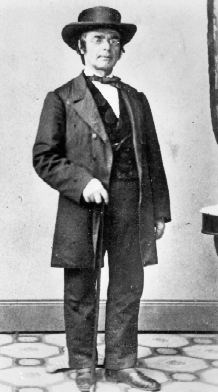Henry Engelhard Steinway
| Henry E. Steinway | |
|---|---|

Henry E. Steinway. This studio photo was taken by Mathew Brady, a noted Civil War-era photographer.
|
|
| Born |
Heinrich Engelhard Steinweg February 15, 1797 Wolfshagen im Harz, Brunswick-Wolfenbüttel, Holy Roman Empire (now Langelsheim, Lower Saxony, Germany) |
| Died | February 7, 1871 (aged 73) New York, New York, United States |
| Occupation | Piano manufacturer |
| Known for | Founding the piano company Steinway & Sons |
Heinrich Engelhard Steinweg, anglicized name Henry Engelhard Steinway (February 15, 1797 – February 7, 1871) made pianos in Germany and the United States. He was the founder of the piano company Steinway & Sons.
Steinway was born Heinrich Engelhard Steinweg in Wolfshagen im Harz, Duchy of Brunswick in the Holy Roman Empire of the German Nation (modern Germany). His childhood was marked by many tragedies and twists of fate. He attended public school in his home town. At the age of 8, he was an orphan and thrown upon his own resources, until his father and brothers, once thought to have been killed in action, returned and claimed him once more. Then, at 15, he was orphaned once again, and it was at this time that he joined the German Army. In 1814, he joined the Schwarze Schar, the volunteer corps of Frederick William, Duke of Brunswick-Wolfenbüttel in the war against Napoleon's occupation of parts of Germany but remained in the garrison throughout the Napoleonic War campaign of the Hundred Days in 1815.
He left service on 23 June 1822 and began to work as a carpenter, and later he became an apprentice to an organ builder in the town of Goslar. He soon discovered his love for music and became an organ player in the church.
He started building instruments, though hidden in the kitchen of his house because of the strong rules of the guild. In Braunschweig, he started by building guitars and zithers, and then graduated to pianos, of small proportions initially and gradually increasing in size.
In 1835 he made the first square piano, which he presented to his bride Juliane at their wedding. In 1836 he built his first grand piano in his kitchen in the town of Seesen. This piano was later named the "kitchen piano", and is now on display at the New York Metropolitan Museum of Art with a Steinweg 1836 square piano. In 1839, he exhibited three pianos at the state trade exhibition in Braunschweig, Germany and was awarded a gold medal.
...
Wikipedia
